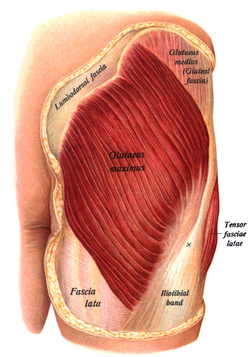Gluteus Maximus: Difference between revisions
No edit summary |
No edit summary |
||
| Line 6: | Line 6: | ||
= Description = | = Description = | ||
[[Image:Glutmax2.png|frame|right|Gluteus Maximus]] The largest of all gluteal muscles that is located at the posterior aspect of hip joint. Its size allows it to generate a large amount of force. The muscle evolved from an adductor of the hip which is still seen in lower primates today. The development of the muscle's function is associated with the erect posture and changes to the pelvis. It now functions to maintain the erect posture as one of the muscles that extends the hip joint.<br> | [[Image:Glutmax2.png|frame|right|Gluteus Maximus]] The largest of all gluteal muscles that is located at the posterior aspect of hip joint. Its size allows it to generate a large amount of force. The muscle evolved from an adductor of the hip which is still seen in lower primates today. The development of the muscle's function is associated with the erect posture and changes to the pelvis. It now functions to maintain the erect posture as one of the muscles that extends the hip joint.<br> | ||
The fibres of Gluteal maximus are largely perpendicular to each other and line up in the direction of pull giving it it's quadrilateral shape and course appearance. There are two layers to the muscle which pass down to the insertional attachment.< | The fibres of Gluteal maximus are largely perpendicular to each other and line up in the direction of pull giving it it's quadrilateral shape and course appearance. There are two layers to the muscle which pass down to the insertional attachment.<ref name="pala">Palastanga N, Soames R. Anatomy and Human Movement: Structure and Function. 6th ed. London, United Kingdom: Churchill Livingstone; 2012.</ref> | ||
= Anatomy = | = Anatomy = | ||
Revision as of 16:20, 22 February 2016
Original Editor - Joanne Garvey
Top Contributors - George Prudden, Joanne Garvey, Kim Jackson, Ahmed Nasr, Lucinda hampton, Admin, Joao Costa, Rachael Lowe, Khloud Shreif, Richard Benes, Sai Kripa, Wendy Walker, Evan Thomas, WikiSysop, Candace Goh and Kai A. Sigel
Description[edit | edit source]
The largest of all gluteal muscles that is located at the posterior aspect of hip joint. Its size allows it to generate a large amount of force. The muscle evolved from an adductor of the hip which is still seen in lower primates today. The development of the muscle's function is associated with the erect posture and changes to the pelvis. It now functions to maintain the erect posture as one of the muscles that extends the hip joint.
The fibres of Gluteal maximus are largely perpendicular to each other and line up in the direction of pull giving it it's quadrilateral shape and course appearance. There are two layers to the muscle which pass down to the insertional attachment.[1]
Anatomy[edit | edit source]
Origin[edit | edit source]
Insertion[edit | edit source]
Nerve supply[edit | edit source]
The gluteus maximus is supplied by the inferior gluteal nerve (root L5, S1 and S2). Cutaneous supply is mainly provided by L2 and 3.[1]
Function[edit | edit source]
Its primary role is to extend and laterally rotate the hip.
It also prevents excessive anterior rotation of the pelvis and assists with the stability of the sacro-iliac joint by providing force closure for this joint. Gluteus maximus is part of the posterior sling of muscles.
Due to its insertion sites, it is able to act as an abductor as well as an adductor of the hip joint. The part that inserts into the iliotibial tract abducts, while the fibres that insert into the gluteal tuberosity serve to adduct the hip.
Both glutei maximi may assist in the contraction of the external sphincter ani.
It is particularly active when climbing stairs, or when rising from sitting [2]
Recent research indicates that contraction of the deep abdominal muscles may assist with the contraction of gluteus maximus to assist with the control of anterior pelvic rotation.[3]
Gluteal muscle weakness has been proposed to be associated with a number of lower limb injuries. Recent research indicates that effective exercise to specifically target the gluteus maximus muscle includes the single leg squat and the singe leg prone dead lift. These exercises elicited the most significant activity in electromyography (EMG) when tested against other forms of exercise.[4]
Assessment[edit | edit source]
Palpation[edit | edit source]
Power[edit | edit source]
Length[edit | edit source]
Treatment[edit | edit source]
Resourses[edit | edit source]
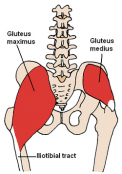
|
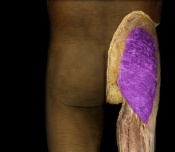
|
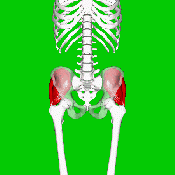
|
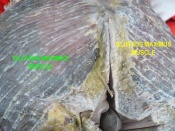
|

|
See also[edit | edit source]
Recent Related Research (from Pubmed)[edit | edit source]
References[edit | edit source]
- ↑ 1.0 1.1 Palastanga N, Soames R. Anatomy and Human Movement: Structure and Function. 6th ed. London, United Kingdom: Churchill Livingstone; 2012.
- ↑ Norkin C; Levangie P; Joint Structure and Function: a comprehensive Analysis 2nd Ed; 1992; 320-321
- ↑ Kim TW, Kim YW.Effects of abdominal drawing-in during prone hip extension on the muscle activities of the hamstring, gluteus maximus, and lumbar erector spinae in subjects with lumbar hyperlordosis; J Phys Ther Sci. 2015 Feb;27(2):383-6
- ↑ Distefano LJ, Blackburn JT, Marshall SW, Padua DAGluteal muscle activation during common therapeutic exercises; J Orthop Sports Phys Ther. 2009 Jul;39(7):532-40
